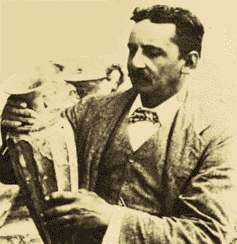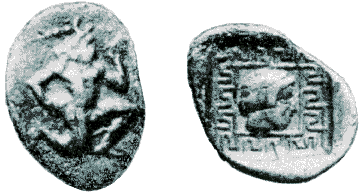|

. Before work
began in Crete by the British archaeologist Evans at Knossos (1900), and
his American contemporary Harriet Boyd at Gournia (1901-1901),
knowledge of the Bronze Age Minoan culture was only faintly reflected in
a few Classical Greek myths. By the time this pioneering work was finished
several decades later, the Minoan periods on Crete had been defined well
enough to identify them as a major civilization from ca. 1900-1300 BC.
Fig.1: Arthur Evans holding a Minoan vase.
Evans was particularly drawn to Crete as one such source of seals containing
undeciphered early inscriptions. The ancient town site of Kafala (Knossos)
on the northern coast of Crete, next to the capital city of Herakleion, was
well-known to local inhabitants, who plowed up ancient objects, including
pottery, coins, and seals, as they cultivated their fields. Knossos had been
occupied up through the Roman period, and during the Classical and Hellenistic
eras (500-200 BC) had issued its own coinage, which interestingly showed
pictures of labyrinths, Minotaurs, and Ariadne, the stuff of later
interpretations (fig.2).
First to excavate
at Knossos was an Herakleion merchant and antiquarian, aptly named Minos
Kalokairinos, who in 1878 uncovered foundations of store rooms filled with
large pithos jars. Documentation of Kalokairinos' work by William Stillman,
US Consul in Crete at the time, identifies the finds as being from the west
magazine of the palace. Stillman also (somewhat prophetically) provides a sketch of the "Labyrinth of Daedelus," a portion of the foundations also
dug up by Kalokairinos, and later identified as the Throne Room (Shaw 1990).
 Fig.2: Classic-era silver coin from Knossos (425-330 BC). At left,
the obverse shows a Minotaur, while the reverse at right shows the head of
Ariadne, surrounded by a meander pattern representing the labyrinth (CNG;
SG-3211). Fig.2: Classic-era silver coin from Knossos (425-330 BC). At left,
the obverse shows a Minotaur, while the reverse at right shows the head of
Ariadne, surrounded by a meander pattern representing the labyrinth (CNG;
SG-3211).
Turkish landowners, however, soon stopped the Kalokairinos investigations.
Shortly thereafter, the famed German archaeologist Heinrich Schliemann, excavator
of Troy and Mycenae, attempted to purchase the "Kefala hill" - actually a
"tell," or artificial, mound caused by long-term occupations at Knossos since
the Neolithic (see
Macdonald, this issue)
- but refused to pay prices he considered exorbitant.
Evans first visited Crete in 1894 to study and decipher two types of unknown
scripts appearing on Cretan seals. A year later he published the results
in the Ashmolean publication Cretan Pictographs and Prae-Phoenician Script
(Evans 1895), therein identifying both the enigmatic Minoan hieroglyphs
("Pictographs"), and the syllabic or pre-alphabetic ("Prae-Phoenician") scripts,
now called Linear A and B.
Political fortunes then played a part in assisting Evans to excavate in Crete,
after the island had won its independence from Turkey. In 1899, Evans used
money  from
a family inheritance to buy the site at Kefala. Using a sizable local work
force, Evans began large-scale, systematic excavations at Knossos in 1900,
and by the end of 1903 had uncovered many of the foundations of the large,
sprawling structures he designated as the Palace. from
a family inheritance to buy the site at Kefala. Using a sizable local work
force, Evans began large-scale, systematic excavations at Knossos in 1900,
and by the end of 1903 had uncovered many of the foundations of the large,
sprawling structures he designated as the Palace. Fig.3: Reconstructed pillars and shield fresco at Knossos (photo:
Athena Review).
Restorations and reconstructions of portions of the walls and foundations
often used reinforced concrete (fig.3), with reconstructed timber frames
and other wooden structures painted in a pink or buff color. Numerous examples
of the now famous frescoes, discovered mainly as small fragments, were boldly
restored. Evans is also responsible for restoring many of the now famous
rooms within the palace, such as the Throne Room, with its pair of griffins
in a fresco flanking a gypsum stone seat. These restoration methods have
been often criticized for both over-interpretation of sometimes scanty remains,
and for using materials foreign to Minoan architecture.
Besides his pioneering work in excavating the main palace site, among Evans'
most significant discoveries at Knossos was the recovery of about 3000 ancient
Linear A and B writing
tablets. Linear B eventually proved to be an early form of ancient Greek
from a later, Mycenaean occupation of the site. Linear A, a script representing
the language of the Minoans, still remains largely undeciphered.
Evans continued his research until 1931, with an interruption for the First
World War. He published his monumental work in four volumes entitled The
Palace of Minos at Knossos (1921-1935). When Arthur Evans died in 1941, the
British School of Archaeology took up further investigations at Knossos,
continued to this day (see
Macdonald, this
issue). Despite many detractors, Evans stands as a major archaeologist whose
creative imagination, motivation, and scholarship led him from an initial
interest in inscriptions on tiny, carved seals to the discovery and documentation
of Knossos, largest site of the Minoan civilization.
References: Evans, Arthur C. 1921-1935. The
Palace of Minos at Knossos (4 vols.). MacMillan and Co., London.
This article appears on page 19 in Vol.3 No.3 of Athena
Review.
.
|
|